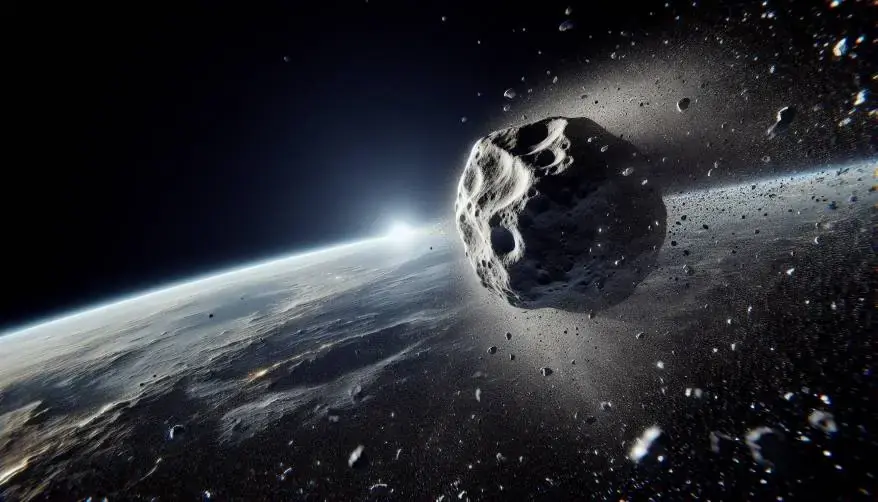NASA Asteroid Hitting Earth? Asteroid 2024 YR4
Estimated reading time: 3 minutes
A newly discovered asteroid, named 2024 YR4, is currently under close observation by NASA. There is a small chance it might hit Earth. This could happen on December 22, 2032. Since its discovery in December 2024, scientists have been tracking it closely. Scientists’ estimate the NASA Asteroid Hitting Earth to be between 40 and 90 meters (130 and 300 feet) wide. It is currently at the top of NASA’s Asteroid watch list. However, a NASA Asteroid Hitting Earth still has a very low probability.
Impact of NASA Asteroid hitting Earth?
Initially, the probability of impact was around 1.2%. But it has since increased to 2.3%. Some reports had the risk at 1.9%. This translates to roughly a 1-in-43 or 1-in-45 chance of impact. As more data becomes available, this probability could either decrease or increase.
It is possible that NASA Asteroid Hitting Earth 2024 YR4 will be ruled out as an impact hazard. Many other asteroids have been on NASA’s risk list before. Later, scientists found they would not hit Earth either.
Size and Potential Damage
The asteroid is large enough to cause localized damage if it were to hit Earth. According to current models, if Nasa Asteroid Hitting Earth 2024 YR4 were to collide with Earth, the explosion could unleash the equivalent of 15 megatons of TNT.
“2024 YR4 could be 40 m across and very reflective, or 90 m across and not very reflective,” ESA officials explained.
Scientists estimate that it would release about 8 megatons of energy upon impact.
James Webb Telescope to Refine Size Estimates
To get a better understanding of the asteroid, NASA is utilizing the James Webb Space Telescope (JWST). NASA has granted an international team of astronomers emergency use of the JWST. The telescope’s infrared instruments will measure the heat emitted by the asteroid. Measuring the heat emitted by the asteroid helps determine its size. The first observations were scheduled for March 2025. A follow-up observation will take place in May as YR4 moves away from the Sun. This offers the last opportunity for study until the asteroid returns in 2028. Unlike ground-based telescopes, JWST’s position in space allows it to avoid interference from Earth’s atmosphere, giving it a clearer view.
Also Read: JWST Provides New Insights into the Universe’s Expansion
Discovery by ATLAS
The Nasa Asteroid hitting Earth, was first spotted on December 27, 2024, by the Asteroid Terrestrial-impact Last Alert System (ATLAS). The discovery was made at the El Sauce Observatory in Chile. NASA funds and the University of Hawaii’s Institute for Astronomy manages ATLAS.
Monitoring and Notifications
2024 YR4 has surpassed the 1% impact probability threshold. For this reason, it warrants formal notification to other U.S. government agencies. These agencies are involved in planetary defense. Notifications have also been sent to the Space Mission Planning Advisory Group and to the United Nations Office of Outer Space Affairs. This is in accordance with the International Asteroid Warning Network’s notification charter.
NASA is continuously refining its tracking of 2024 YR4. They are using their network of telescopes, including the repurposed WISE Space Telescope. Scientists expect future enhancements, like a planned infrared space telescope dedicated to asteroid detection, to improve tracking accuracy.
You can stay up-to-date on the asteroid’s progress through NASA’s automated Sentry page.
Reference
Wasser, A. M. L. (2025, February 7). NASA continues to monitor orbit of Near-Earth Asteroid 2024 YR4 – Planetary Defense. https://blogs.nasa.gov/planetarydefense/2025/02/07/nasa-continues-to-monitor-orbit-of-near-earth-asteroid-2024-yr4/
To stay updated with the latest developments in STEM research, visit ENTECH Online. This is, in fact, our digital magazine for science, technology, engineering, and mathematics.
Disclaimer
We do not intend this article/blog post to provide professional, technical, or medical advice. Therefore, please consult a healthcare professional before making any changes to your diet or lifestyle. In fact, we only use AI-generated images for illustration and decoration. Their accuracy, quality, and appropriateness can differ. So, users should avoid making decisions or assumptions based only on the text and images.






